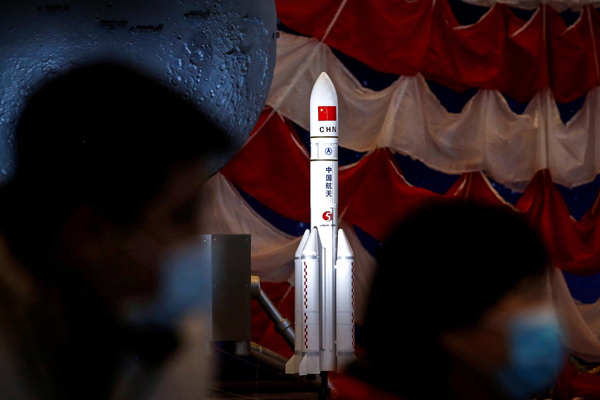China is showcasing a number of elements for future human lunar landing missions at a major airshow and stating that super heavy-lift rocket will be ready by 2028.
Two super heavy-lift rockets, the return capsule from a prototype new-generation crew spacecraft, its parachutes and a Chang’e-5 spacecraft were on display at the 13th Zhuhai Airshow recently.
The in-development launchers and crew spacecraft could provide China with the capabilities to land astronauts on the moon by around 2030. Beyond this the largest rocket would also be able to deliver architecture to the lunar surface for long-term stays.
A model of Chang’e-5 was also showcased. In 2020 the mission demonstrated some of the maneuvers and technologies—lunar orbit rendezvous and docking and high-speed skip reentry—required to get astronauts safely back home.
Together the exhibits illustrate China’s current plans for getting to the moon and back and the changes to previous thinking.
The so-called new-generation crewed launch vehicle stands among models of various Long March vehicles at the China Aerospace Science and Technology Corp. (CASC) exhibition area.
CASC is developing the new launcher to meet requirements from the China Manned Space Engineering Office (CMSEO) which is responsible for the country’s human spaceflight endeavors.
It will comprise of three, five-meter-diameter first stage cores based on the Long March 5 and clusters of YF-100K engines—uprated versions of the YF-100 kerosene engines used by sChina’s new Long March 5, 6 and 7 launchers—and be capable of sending 27 tons into lunar transfer orbit.
The new launcher will be 90 meters in length and have a takeoff mass of 2,211 tons, up from 87 meters and around 2,000 tons in earlier reports. It will have the capacity to launch a new-generation crew spacecraft with deep space travel capabilities, including withstanding temperatures of up to 3,000 degrees Celsius on reentry.
In June senior space industry official and Long March rocket designer Long Lehao presented a mission architecture using two launches of the new crew rocket, referred to as “Long March 5 Dengyue (“moon landing”),” to put two astronauts on the lunar surface for six hours. Such a mission would use the new crew spacecraft and could be possible by around 2030, according to the presentation. China is also known to be working on a lunar lander, though a design has not been publicly unveiled.
The rocket will also inherit the design, reliability and high safety standards of the Long March 2F launcher used to launch Shenzhou missions, Liu Bing, deputy director designer of the General Design Department at the China Academy of Launch Vehicle Technology (CALT), told Science and Technology Daily. The new launcher concept first appeared at the 2018 edition of the Zhuhai Airshow.
Capable of launching 70 tons to LEO, the crew launcher would have nearly three times more payload capacity than China’s current largest rocket, the Long March 5.
CASC says the launcher will be used for future human lunar exploration projects such as as circumlunar, lunar orbit and landing missions. A provisional date for its first flight has not been revealed and appearance is not finalized.











